Ion Channels: Structure, Function, and Mechanisms
1/110
There's no tags or description
Looks like no tags are added yet.
Name | Mastery | Learn | Test | Matching | Spaced |
|---|
No study sessions yet.
111 Terms
What are the three basic functional properties of ion channels?
Conduct, Select, Gate.
Why are ion channels necessary for ion movement across cell membranes?
Ions cannot diffuse across the hydrophobic barrier of the membrane lipid bilayer.
How do ion channels facilitate ion diffusion?
They provide a polar environment for diffusion of ions across the membrane.
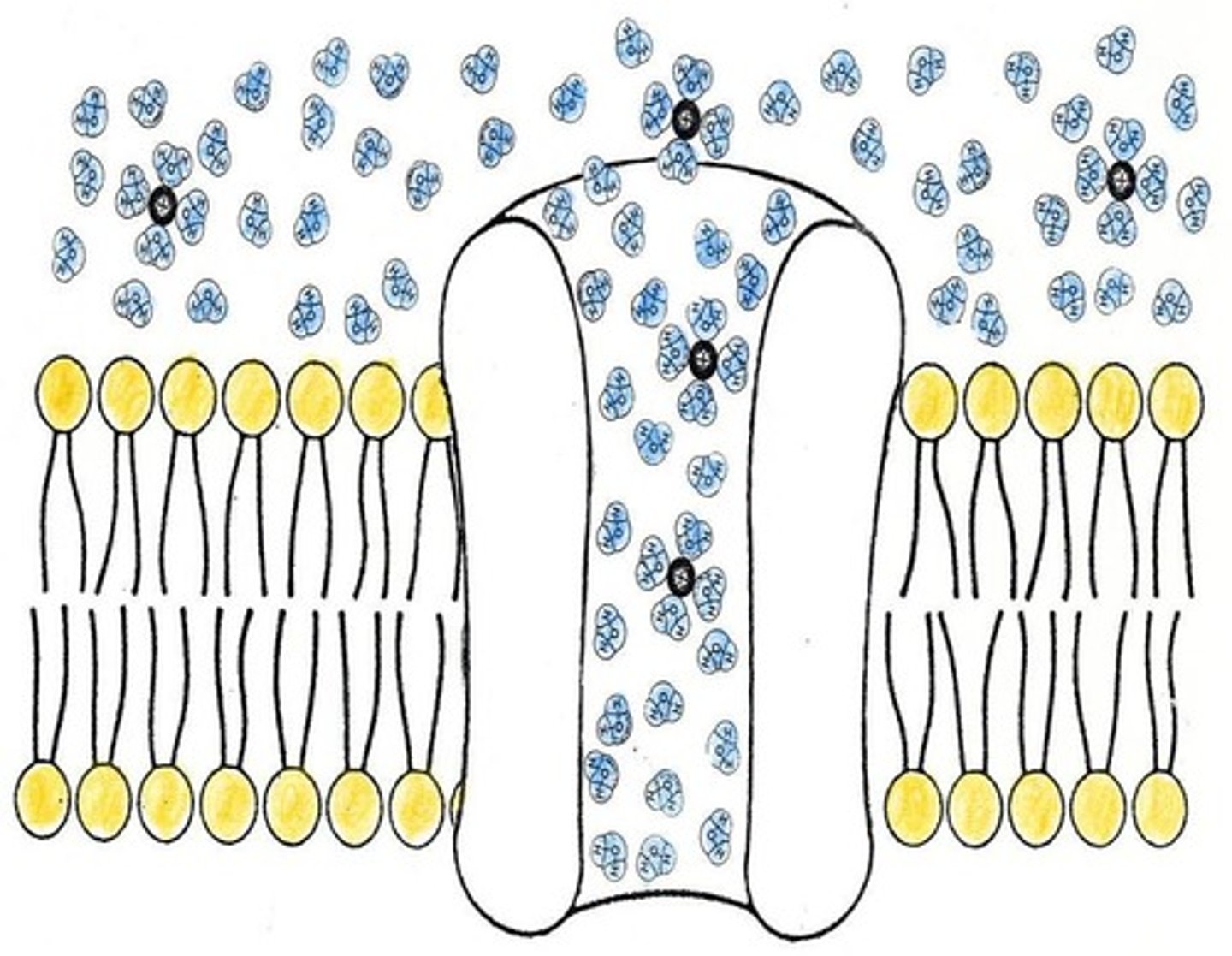
What role do ion channels play in the nervous system?
They mediate the generation, conduction, and transmission of electrical signals.
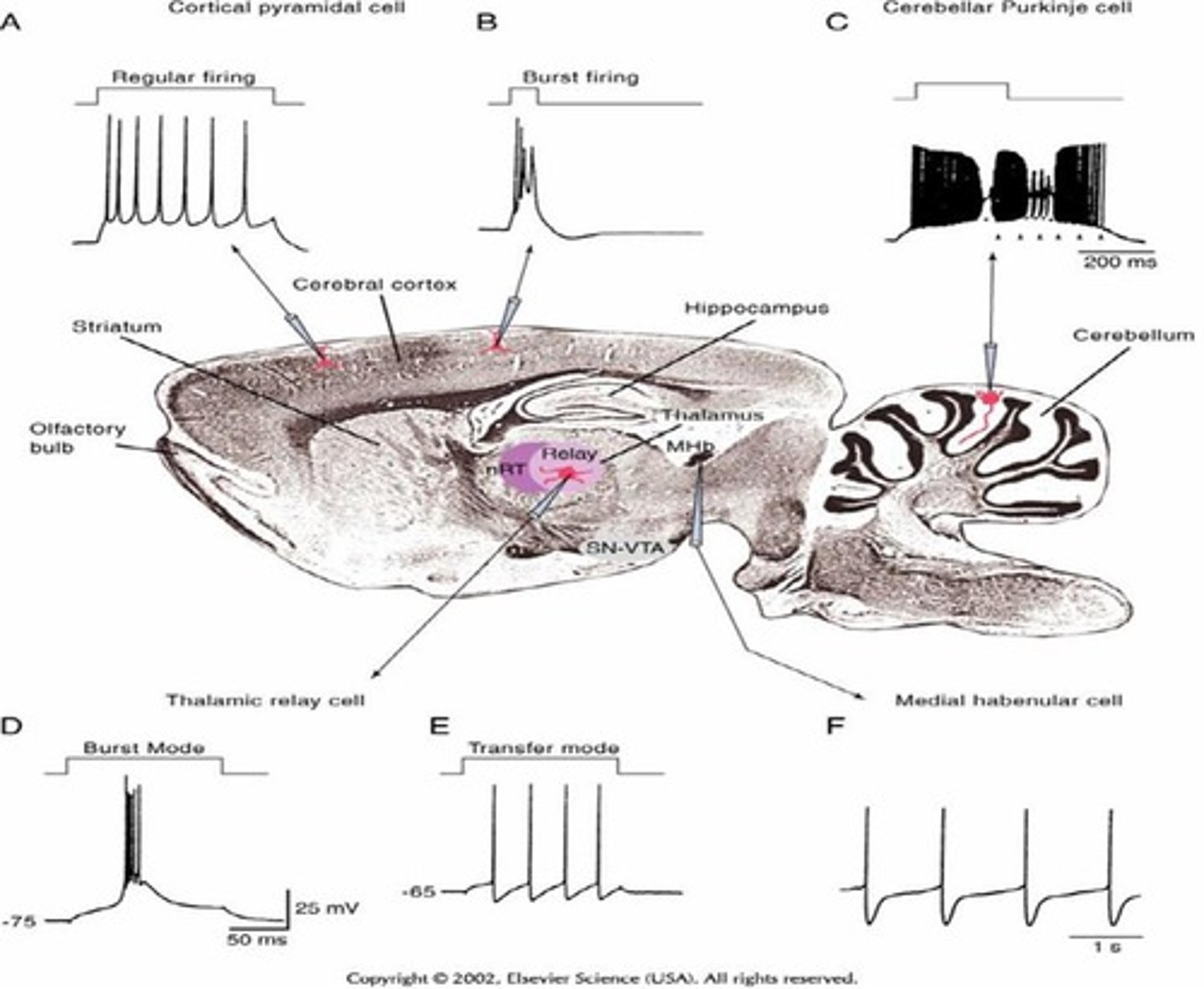
What is one function of ion channels beyond the nervous system?
They transfer small molecules between cells (gap junctions).
How do ion channels contribute to fluid transport?
They mediate fluid transport in secretory cells.
What is the significance of ion channels in cell motility?
They control the motility of growing and migrating cells.
What is meant by selective permeability in the context of ion channels?
Ion channels provide selective permeability properties important for various intracellular organelles.
What are the two types of oligomers that make up ion channels?
Homoooligomers (constructed from a single type of subunit) and heterooligomers (constructed from distinct subunits).
What are auxiliary subunits in ion channels?
They are additional subunits (β or γ) that modulate the gating characteristics of the central core.
What determines the properties of a protein in ion channels?
The amino acid sequence, known as the primary structure.
What is the role of secondary structures in proteins?
They form parts of the molecule such as alpha helices (coils) or beta sheets (flat) that contribute to the protein's 3D structure.
What is the thermodynamically most stable configuration of a protein?
The precise 3-dimensional conformation achieved through the folding of polypeptide chains.
What is the primary structure of a protein?
The amino acid sequence of the protein.
What is the function of the pore-forming α subunits in ion channels?
They form the central core of the ion channel.
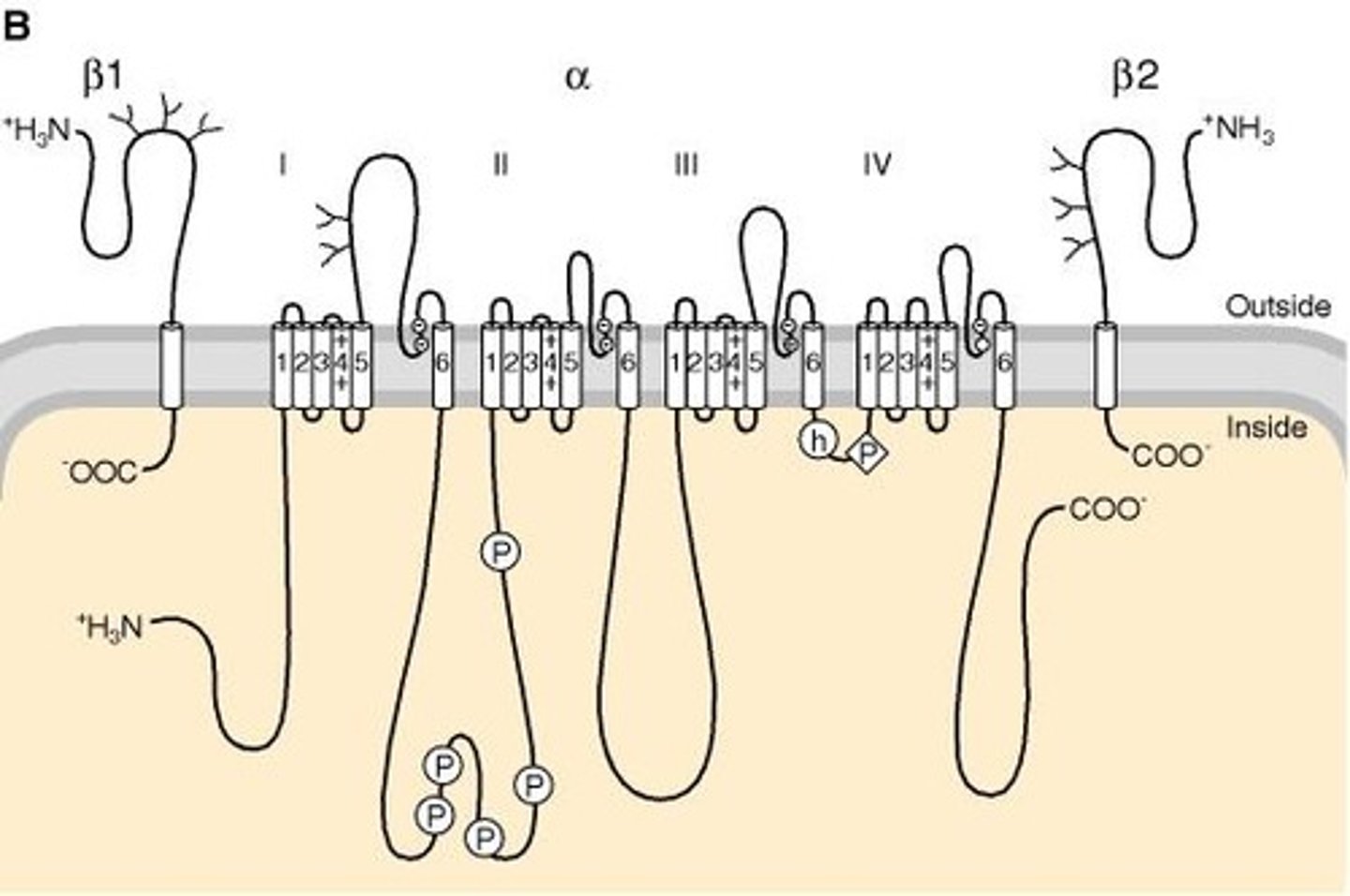
What is the significance of the 3D structure of proteins?
It is essential for the protein's function and stability.
How do ion channels control neurotransmitter release?
By mediating the electrical signals that trigger the release.
What is the relationship between ion channels and electrical signals in the nervous system?
Ion channels are crucial for the generation and transmission of these signals.
What is the role of ion channels in intracellular organelles?
They provide selective permeability necessary for the function of various organelles.
How does the arrangement of amino acids affect protein structure?
It determines the formation of secondary structures and the overall 3D conformation.
What results from further folding and reorganization within a molecule?
Higher order, or tertiary structure.
What reflects the diverse firing properties of neurons?
Diversity in ion channels.
What are the two major subclasses of ion channels?
Voltage-gated and ligand-gated.
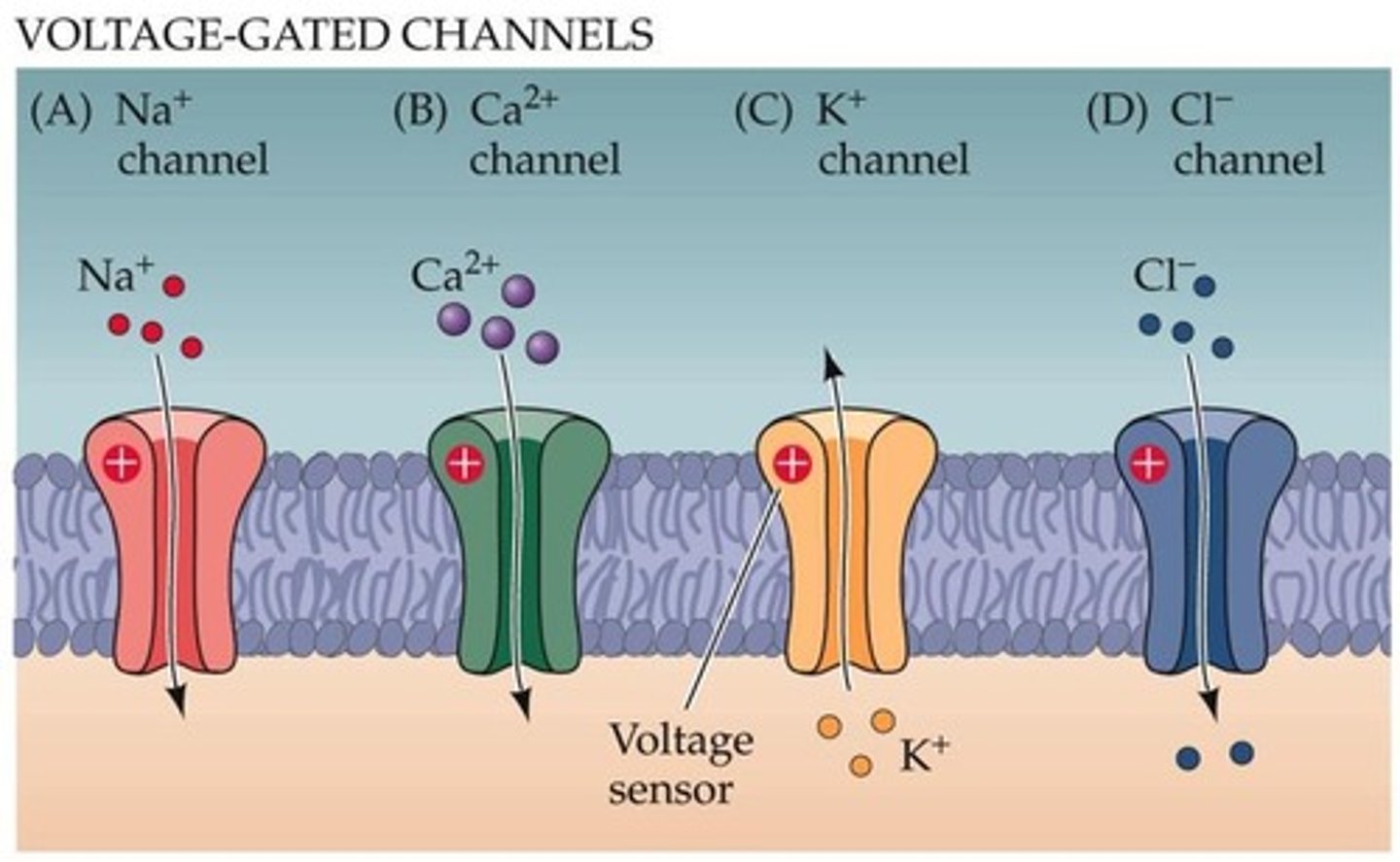
How many ion channel genes have been identified?
Over 100 ion channel genes.
What is the topology of voltage-gated Na+ channels?
1 subunit with 4 domains.
What is the topology of voltage-gated Ca++ channels?
1 subunit with 4 domains.
What is the topology of voltage-gated K+ channels?
4 subunits with 1 domain.

How many transmembrane regions does each domain of voltage-gated channels have?
6 transmembrane regions.
What is the main component of the Na+ channel?
The α subunit, which forms the ion conducting pore.
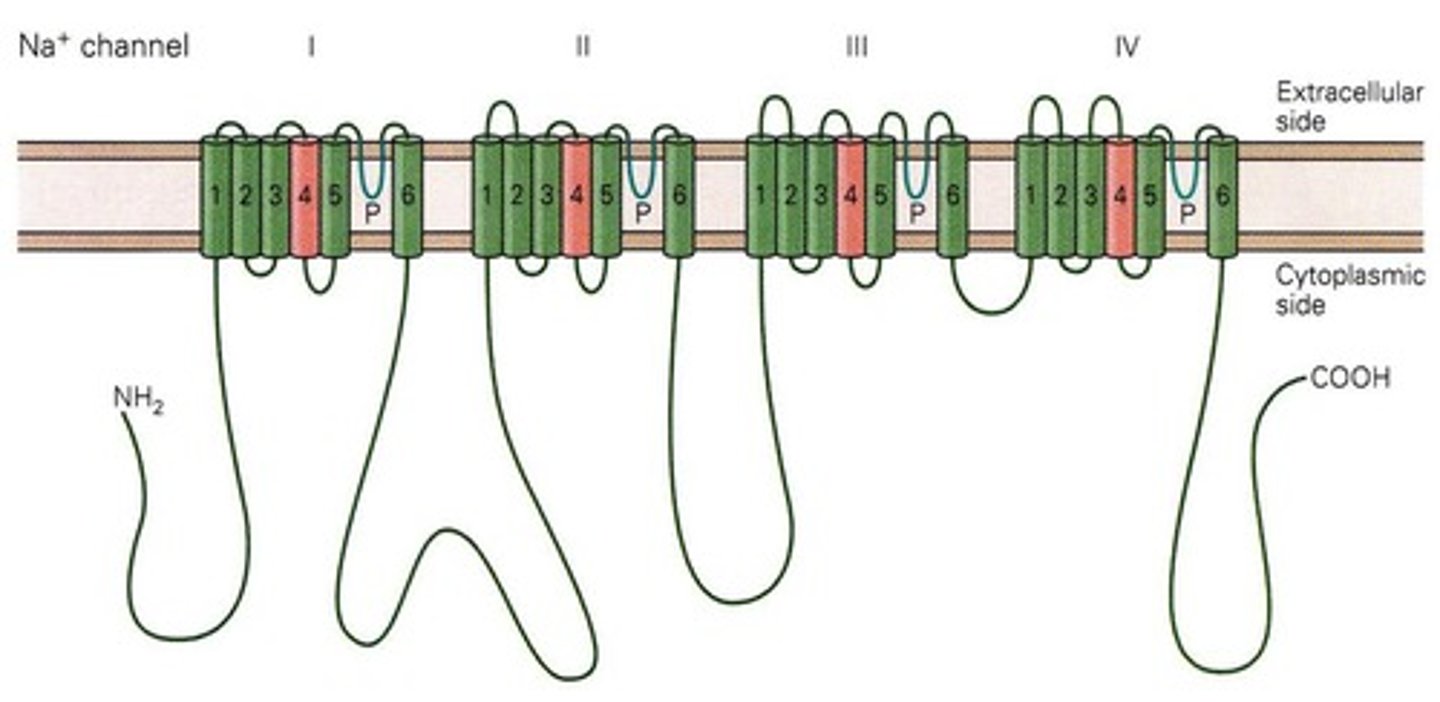
What role do β subunits play in ion channels?
They are accessory subunits that affect channel properties and target channels to the membrane.
What is the function of the α1 subunit in Ca++ channels?
It serves as the ion conducting pore.
What are the accessory subunits in Ca++ channels?
α2δ, β, and γ subunits, which affect ion channel properties and targeting to the membrane.
Which antiepileptic drugs target the α2δ subunit of Ca++ channels?
Gabapentin (Neurontin) and pregabalin (Lyrica).
What is the function of the S4 region in the Na+ channel?
It acts as a voltage sensor with positively charged amino acids.
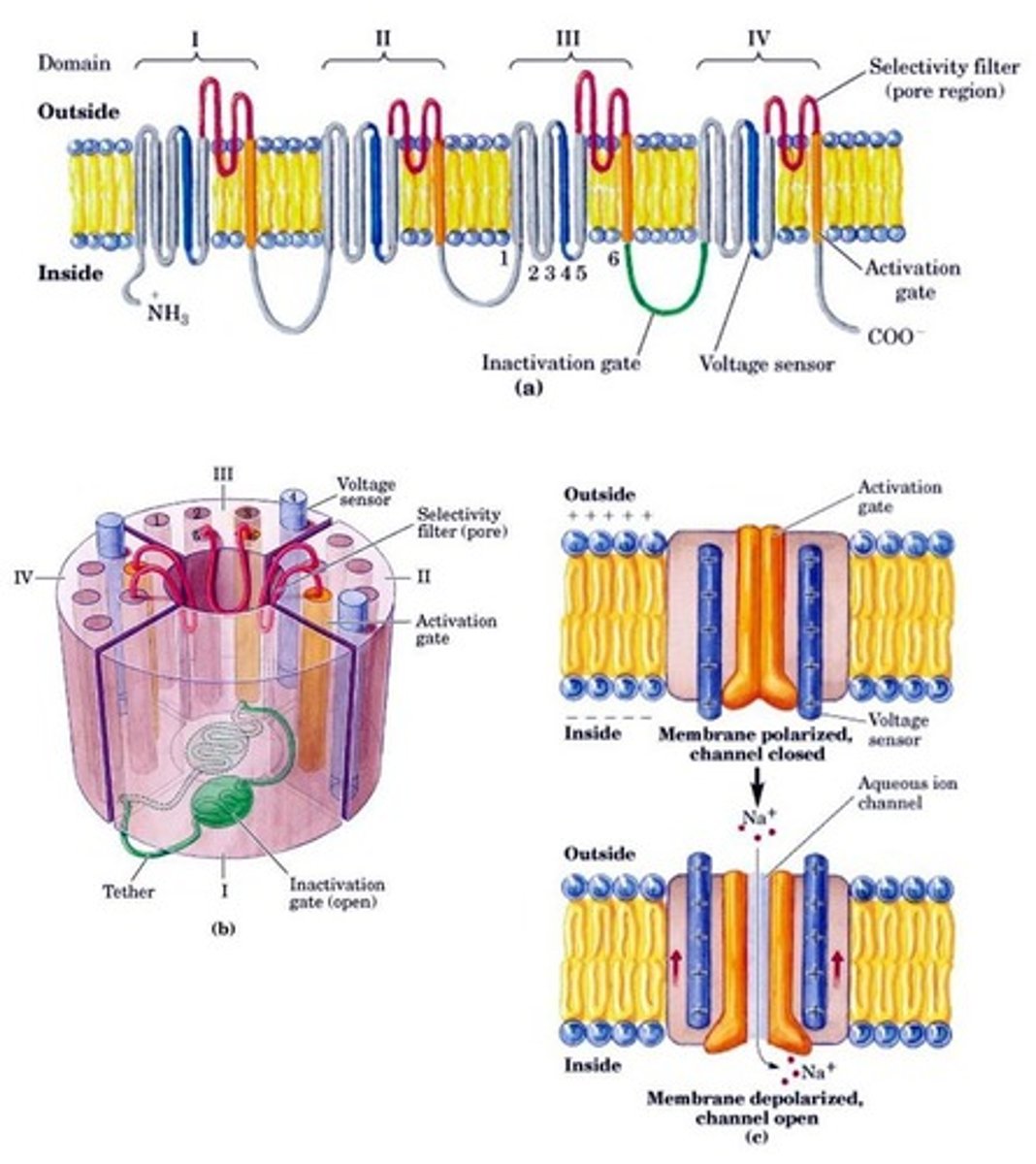
What happens to the Na+ channel during depolarization?
It causes a conformational change in the channel.
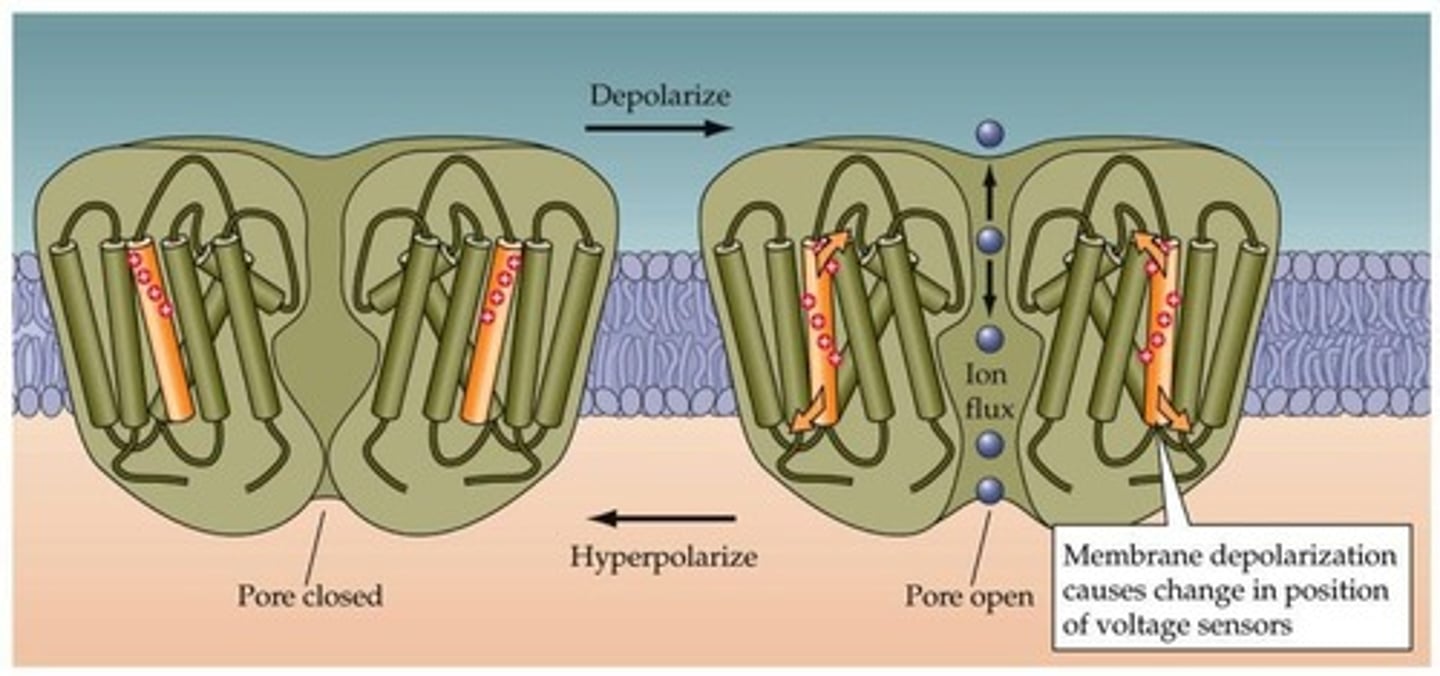
What is the conduction rate of ion channels?
Up to 10^8 ions per second.
What do ion channels do to ion fluxes?
They speed up ion fluxes without imparting energy.
What is the major driving force of ion fluxes in ion channels?
The electrochemical potential.
What types of channels recognize and select for specific ions?
Anion permeable channels and cation permeable channels.
Which ions are recognized by cation permeable channels?
Na+, K+, and Ca2+.
Which ion is recognized by anion permeable channels?
Cl-.
What is the all-or-none fashion in ion channel gating?
Ion channels open and close in an all-or-none manner, with differential times for opening and closing.
What factors can cause ion channels to gate?
Specific electrical, mechanical, and chemical signals.
What is the relationship between macroscopic channel currents and individual channels?
Macroscopic channel currents are the sum of currents flowing through many individual channels.
What are the types of gating controls for ion channels?
Ligand gated, Voltage gated, Mechanical force gated, Phosphorylation, Temperature.
How does voltage affect Na+ currents in ion channels?
Currents increase with depolarization as more channels open and decrease as the voltage approaches the equilibrium potential.
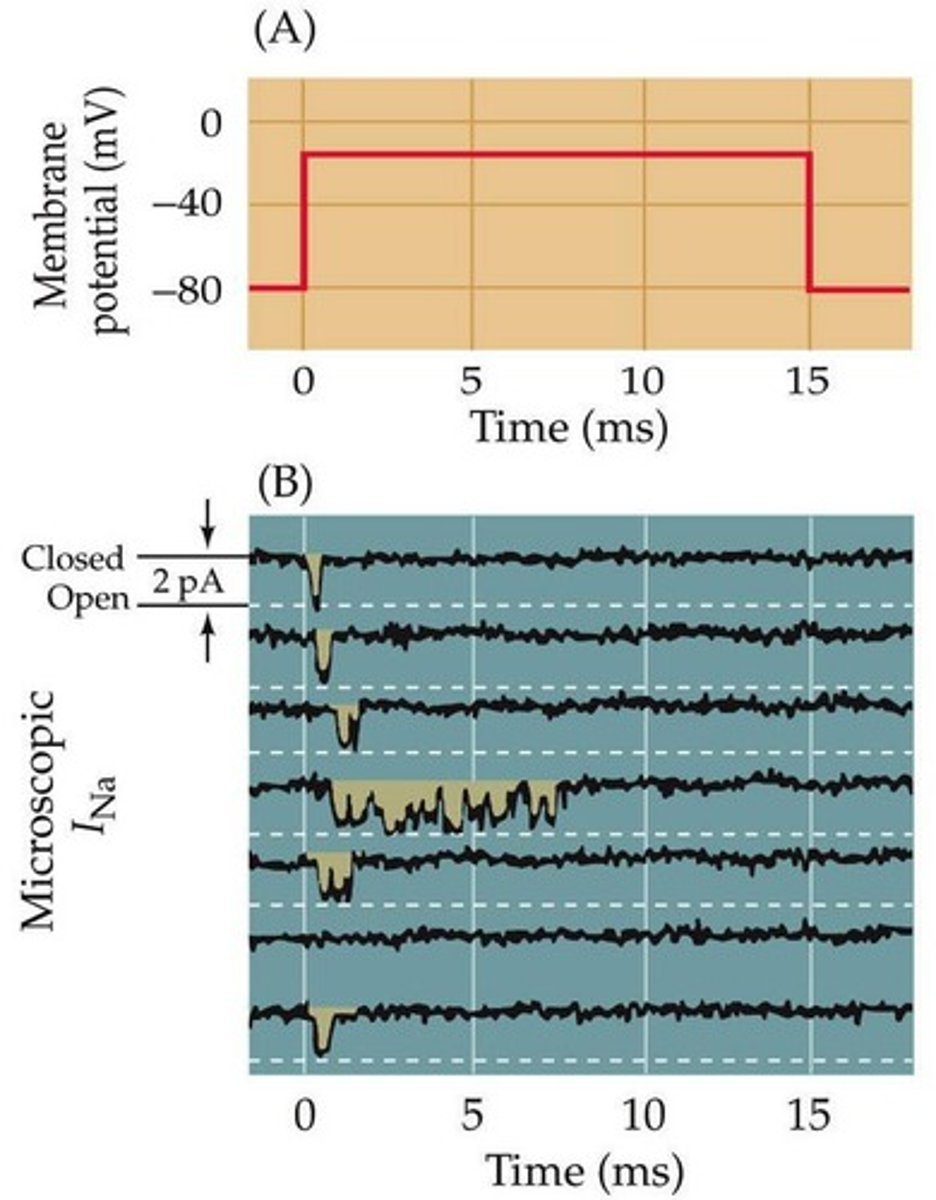
What is the significance of ion selectivity in action potentials?
Without selective ion channels, Na+ influx would be cancelled out by K+ efflux, preventing action potentials.
What are the mechanisms for selectivity in ion channels?
Selectivity is based on atomic radius, surface charge density, and hydrated ionic radius.
How do Na+ channels achieve selectivity?
Na+ fits through the pore with a water molecule attached, while K+ is too large to fit through with a water molecule.
How do K+ channels achieve selectivity?
K+ fits through the pore without a water attached, while Na+ is too small to be stabilized correctly without water.
What are the two gates in Na+ channels?
Activation gate and inactivation gate.
What is the state of the activation and inactivation gates at rest in Na+ channels?
At rest, the activation gate is closed and the inactivation gate is open.
What happens to the activation gate during membrane depolarization?
The activation gate opens due to movement of charged residues in the voltage sensor, allowing Na+ ions to flow into the cell.
What occurs after the activation gate opens in Na+ channels?
The inactivation gate closes, preventing further Na+ flow through the channel.
What is the role of exogenous compounds in channel gating?
They can act as channel gating modifiers by binding to the channels.
What is the significance of the size of ions in channel selectivity?
Ions must be stabilized in the channel pore, and size affects their ability to enter.
What is the effect of temperature on ion channel gating?
Temperature can act as a gating control for ion channels.
What happens to Na+ currents as the voltage approaches the equilibrium potential?
The currents get smaller due to decreased driving force.
What is the function of the voltage sensor in Na+ channels?
It causes the activation gate to open in response to membrane depolarization.
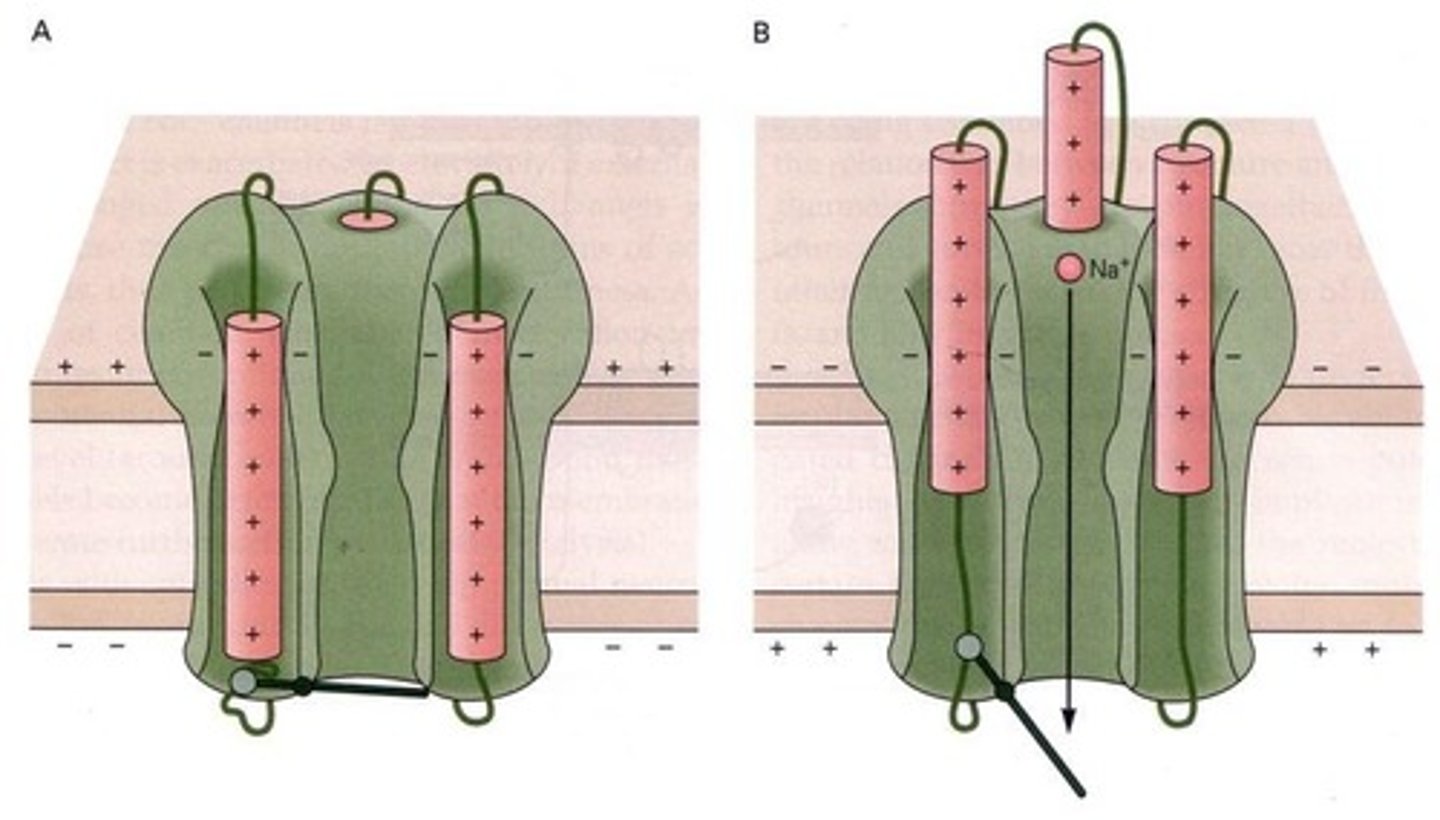
What is the importance of ion channels in cellular function?
They are essential for generating action potentials and regulating ion flow across membranes.
What must occur for sodium channels to reset?
The inactivation gate must re-open and the activation gate must close.
What are the two gates of the sodium channel?
Activation and inactivation gates.
Describe the cycle of sodium channel states.
It involves a fast response with rapid opening (activation) followed by slower closing (inactivation) and includes a refractory period.
What is the role of S4 in sodium channels?
S4 is thought to be the voltage sensor that, when moved, pulls on S5 and possibly S6 to open the channel.
Which toxins block the ion conducting pore of Na+ channels?
Tetrodotoxin and Saxitoxin.
What is the effect of Veratridine, Batrachotoxin, and Aconitine on Na+ channels?
They cause persistent activation and alter activation and inactivation.
How do Scorpion Toxin and Sea Anemone Toxin affect Na+ channels?
They inhibit inactivation.
What is the mechanism of action of local anesthetics like Lidocaine on Na+ channels?
They block the ion channel from the inside and are more effective on channels that open frequently.
Which antiepileptics have Na+ channel block as part of their mechanism?
Phenytoin, carbamazepine, valproic acid, topiramate, and lamotrigine.
How do G-protein βγ subunits modulate Ca++ channels?
They inhibit voltage-gated Ca++ channels when activated by G-protein coupled receptors.
What is the role of kinases in the regulation of ion channels?
Kinases can phosphorylate channels, leading to enhanced or inhibited function.
What do phosphatases do in relation to ion channels?
Phosphatases remove phosphate groups and can also modulate ion channels.
What is the significance of the refractory period in sodium channels?
It is the period during which the channel cannot be activated again immediately after an action potential.
What is the structural basis of gating in sodium channels?
The movement of S4, which acts as a voltage sensor, is crucial for the opening of the channel.
Which sodium channel types are resistant to tetrodotoxin and saxitoxin?
Nav1.5, Nav1.8, and Nav1.9.
What is the effect of G-protein coupled receptors on ion channels?
They can activate G-proteins that modulate the function of ion channels.
What are the effects of local anesthetics on frequently opening sodium channels?
They are more effective at blocking these channels.
What is the role of the βγ subunit of G-proteins in ion channel modulation?
It can inhibit voltage-gated Ca++ channels.
What are the main components of voltage-gated Na+ channels?
They are made up of 10 genes for the α subunits, 9 of which are highly similar (>70%) at the amino acid level.
What is the nomenclature for voltage-gated Na+ channels?
Nav1.1-1.9 and Nax, with Nax functioning as an external Na+ concentration sensor.
Where are most subtypes of Na+ channels expressed?
In a variety of tissues including heart, muscle, and nerves.
What determines the selectivity of Na+ channels?
The selectivity (Na+ ≈ Li+ > K+ > Ca++) is determined by 4 amino acids (DEKA) in the pore loop domains.
Which Na+ channel subtype is predominantly expressed in the CNS?
Nav1.1, found in the cerebellum, striatum, hippocampus, thalamus, and peripheral neurons.
What is the primary expression pattern of Nav1.2?
Similar to Nav1.1 but mostly found on unmyelinated axons.
What is unique about Nav1.3?
It is widely distributed throughout the brain and peripheral neurons, mostly during embryonic and early postnatal stages, and can be re-expressed following nerve injury.
Which Na+ channel subtype is specific to skeletal muscle?
Nav1.4.
Where is Nav1.5 primarily found?
In cardiac muscle, with low levels of expression in the brain and peripheral neurons.
What characterizes Nav1.6?
It is the most abundantly expressed subtype in the CNS and is the major Na+ channel at nodes of Ranvier in myelinated axons.
What is the primary location of Nav1.7?
Predominantly found in peripheral sensory and sympathetic neurons, expressed in axons and at terminals.
What is the primary function of Nav1.8?
It is primarily found in peripheral sensory neurons and is TTX resistant.
What is the expression pattern of Nav1.9?
Found in peripheral sensory neurons and is also TTX resistant.
What do Na+ currents exhibit in terms of kinetics?
They exhibit variable kinetics, with TTX-sensitive and TTX-resistant currents showing fast and slow inactivation, respectively.
What are the family members of voltage-gated Ca++ channels?
They consist of 10 family members, including Cav1.1-1.4 (L-type), Cav2.1-2.3 (P/Q-type, N-type, and R-type), and Cav3.1-3.3 (T-type).
What is the similarity percentage within and between calcium channel subfamilies?
75% similarity within and 25% between subfamilies.
What are the voltage requirements for high-voltage activated (HVA) channels?
Cav1 and Cav2s require larger changes in voltage (i.e. > -30 mV).
What are the voltage requirements for low-voltage activated (LVA) channels?
Cav3 requires smaller changes in voltage (i.e. > -70 mV).
What ions are selectively mediated by the EEEE residues in calcium channels?
Ba++ > Ca++ > Na+/K+.
Which toxins block L-type calcium channels (Cav1.1-Cav1.4)?
Dihydropyridines (nifedipine), verapamil, diltiazem, calcicludine, and calciseptine.
What type of calcium channels does Cav2.1 represent and what blocks it?
Cav2.1 represents P/Q-type channels, blocked by ω-Agatoxin IVA and funnel web spider toxins.
What type of calcium channels does Cav2.2 represent and what blocks it?
Cav2.2 represents N-type channels, blocked by ω-Conotoxin GVIA, MVIIA, and SVIB.